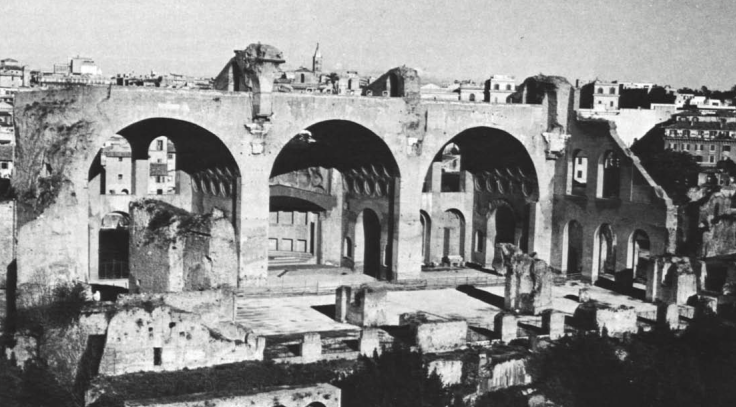Basilica of Maxentius and Constantine. Rome, 307-312/313
The basilica is the capstone of Maxentius' continuation of the First Tetrarchy's architectural patronage in Rome. Rising on the north side of the Via Sacra next to Maxentius' rebuilt Temple of Venus and Roma, its ruins still dominate the Forum to the west. The building was not the traditional multiaisled, wooden-roofed, columnar Roman forensic basilica, but was a unique adaptation of the vast, vaulted frigidarium of the imperial bath type, like that recently completed (305—306) in the Baths of Diocletian.

On entering from the east, one faced an enormous hall covered by three bays of concrete crossvaulting, apparently supported on two files of four colossal Corinthian columns (63 feet each). The long axis terminated in an apsed tribunal. Three great arches on either flank opened into barrel-vaulted alcoves divided by walls with small openings. The terminal walls and those dividing the alcoves from one another supported the roof without the aid of columns, permitting an unusually spacious and unobstructed interior. The interior was strongly lit by lunette windows beneath the vaults and by two rows of large, round-arched windows in the outer walls.
The floor was paved in patterned marble, and the walls were smoothly incrusted with the same marble from the floor to the spring line of the vaults and the sills of the upper tier of windows. The cast-in-place coffers of the vaults were stuccoed, painted, and, perhaps, even gilded.
Although the interior was in the richly decorated tradition of the imperial thermal canon, the exterior, there revealed for the first time, was simply covered with stucco inscribed to imitate ashlar masonry and was chiefly characterized by the rhythmic pattern of its fenestration. This treatment represents something authentically late Roman in important public buildings.
The basilica must have been structurally complete at Maxentius' defeat and death (October 312). The senate rededicated it to Constantine's virtues, an access from the Via Sacra was created, and a new apsed tribunal was constructed opposite it. A colossal, acrolithic, seated statue of Constantine was installed in the older apse (no. 11).
The building had no immediate effect on public architecture, but its vast size, its structural adroitness, and its association with the majesty of Constantine may have challenged Justinian and the builders of Hagia Sophia to surpass it. Bibliography: Minoprio, 1932; Kahler, 1952; Buddensieg, 1962; Harrison, 1967, pp. 92-94.
Date added: 2025-08-01; views: 180;
